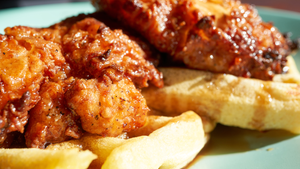How omnichannel is changing the playbook for brands

 This post is part of the 10 Items or Less blog.
This post is part of the 10 Items or Less blog.
A report from Acosta published this week indicates that 97% of all consumer packaged goods dollars are still spent in stores, but that lifestyle and technology changes favor an increasing shift to the virtual channel.
“Amazon’s acquisition of Whole Foods is the perfect example of how the CPG landscape is changing and how technology and online retail have created a shift in the way people shop for groceries,” Colin Stewart, SVP of Acosta, said. “While ecommerce is growing in this space, retailers still have a leg up, as our research has shown the majority of grocery shoppers are still making purchases in store and they find value in doing so.”
Acosta’s report, entitled “Bricks & Clicks — Understanding the Omni Channel Landscape” noted that in particular, CPG products found in the frozen, deli, dairy, meat and produce sections still dominate the in-store purchase preference among all demographics. Not only have fulfillment challenges made those categories slow to come online, but the opportunity to experience them in person still holds sway for the even the savviest digital shoppers.

“Some of the more popular reasons to purchase in-store include selecting fresh foods, using coupons and incentives, satisfying immediate needs, convenience, and to experience new and innovative products,” the report noted. “In fact, 27% of millennial ecommerce shoppers say that sampling foods is one reason to shop in person. Buying fresh foods is the most popular reason for shopping in-store and prepared/frozen items are also a key driver of foot traffic.”
In the virtual world, meanwhile, CPGs are finding brand loyalty may be falling to “lifestyle loyalty” or “ingredient loyalty” or “search result loyalty.”
IRI’s annual Growth Leaders report indicated lesser-known brands that primarily distribute online were among the fastest growing CPG brands in 2016, led by products like Body Armor SuperDrink (sales up by 149.8% last year) and Bai ( 113.9%). In all, IRI noted, brands with less than $1 billion in annual sales grew by 3.1% last year, while midsize brands ($1 billion to $5.5 billion in annual sales) grew by 0.1% and large brands (more than $5.5 billion) saw sales decline by 0.5%.
One reason this is happening is that consumers aren’t searching for brands online but rather for product attributes and ingredients.
“Brands used to be seen as a status symbol of what one could afford,” Mark T. Smucker, CEO of J.M. Smucker Co., said in a conference call last month. “Now they are seen as a signal of one's personal values. Against this backdrop, we see future consumer choices being driven by several trends. Food increasingly needs to fit into non-traditional fast-paced schedules, providing instant fulfillment while also becoming more personalized to meet specific wellness and functional needs.”
 Like a lot of its big-brand peers, J.M. Smucker has been evolving its brand portfolio to appeal to this change, acquiring and investing behind the on-trend nut company Sahale Snacks, for instance. That brand happened to pop up prominently among non-sponsored results when I deliberately vague-searched the term “healthy snacks” at Amazon this morning. Other brands I was only vaguely familiar with also arrived via that search experiment: Crispy Green (freeze-dried fruits); Navitas Organics (Cacao Goji Superfood Power Snacks); Seapoint Farms (dry-roasted edamame); and Better Than Coffee (energy bars).
Like a lot of its big-brand peers, J.M. Smucker has been evolving its brand portfolio to appeal to this change, acquiring and investing behind the on-trend nut company Sahale Snacks, for instance. That brand happened to pop up prominently among non-sponsored results when I deliberately vague-searched the term “healthy snacks” at Amazon this morning. Other brands I was only vaguely familiar with also arrived via that search experiment: Crispy Green (freeze-dried fruits); Navitas Organics (Cacao Goji Superfood Power Snacks); Seapoint Farms (dry-roasted edamame); and Better Than Coffee (energy bars).
That some of these small, fast-growing, “long tail” brands will wind up in the arms of slow-growing, big-head CPG brands is almost a certainty. DrPepper Snapple owns a piece of BodyArmor. Just yesterday, Campbell Soup Co. said it would pay $700 million for natural/organic counterpart Pacific Foods.
I just vague-searched “organic soup” and guess what came up.
About the Author
You May Also Like






